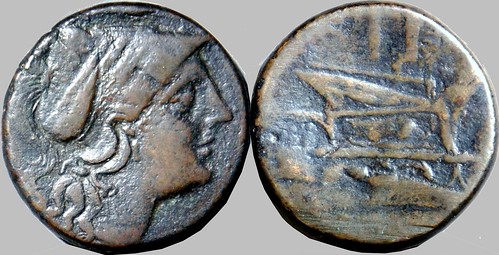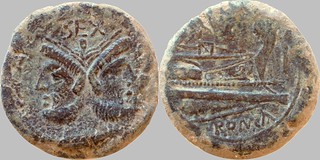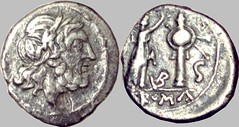Part 4 RRC 67 to RRC 96, 212BC to 207BC, First Denarius coinage in Sicily, Spain and Apulia

|
Specialist Supplements:
1. Roman Coins of Luceria and Canusium
2. Anonymous Struck Bronze Coins of the Roman Republic
3. Anonymous Roman Republican Denarii and Victoriati (Steve Brinkman's site)
Principal Coins of the Roman Republic
Part 4 RRC 67 to RRC 96, 212BC to 207BC, First Denarius coinage in Sicily, Spain and Apulia
RRC 67 Anonymous Victoriatus, Sicily
RRC 68 corn-ear silver, RRC 69 corn-ear and KA triens. Sicily. The RRC 68 corn-ear silver issue has anonymous counterparts: the denarius, the second quinarius, and the sestertius below are anonymous versions of the corn-ear types. These types are linked by style with RRC 69 and should be considered as part of the same issue. The stylistic links between Minerva on the triens and the various Roma busts is clear.
RRC 68 corn-ear anonymous sestertius. Sicily. Davis coll.
RRC 69 corn-ear KA dupondiusMinerva Prow. Michel Amandry and Dominique Hollard, BNF Paris. This dupondius at Paris has until now been classified as RRC 56, with the different prow details due perhaps to understrike details. However comparison with the RRC 69 corn-ear KA Dupondius in London shows them to be from the same dies, and of the same style as other corn-ear and KA denominations. See my discussion in "The Anonymous Struck Bronze Coinage of the Roman Republic: a Provisional Arrangement", 2012.
RRC 69 corn-ear KA or IC bronzes, RRC 70 anonymous victoriatus, RRC 71 C-M victoriatus. Sicily. The quadrans type uses the bull and snake type originally introduced in the collateral RRC 39 semilibral coinage. The RRC 69 quadrantes is very noticeably smaller and typically half the weight of the RRC 72 quadrantes. RRC 69 includes the distinctive KA or IC or ICo or C mintmarks. Crawford does not speculate as to what these stand for but numismatists have traditionally assigned them to Catania. The IC and ICo mintmarks are generally taken to be untidy corruptions of the letter K or KA. This is somewhat of a mystery as it is not clear why an engraver who could clearly write ROMA could not also write the simple letters KA. These coins are generally lighter than the RRC 72 bronzes and are frequently overstruck, for example the Triens over Syracuse democaracy (214-212BC) or over Hieronymous of Syracuse (215-214BC); the Quadrans over Rhegium Apollo/Tripod or over Hieron II Poseidon/Trident (215BC or earlier), and the Sextans over the same Poseidon/Trident type or over Syracuse democracy.
RRC 72 corn-ear silver victoriatus, denarius and quinarius, RRC 72 corn-ear Mars eagle gold 20 As. Sicily. The fine style silver with corn-ear is assigned by Crawford to RRC 72, of undoubtedly better style than RRC 69. Crawford also assigns the gold 20 As with corn-ear to RRC 72. The gold 20 As is the type reported by T.V. Buttrey as being in the probable 211 BC destruction layer at Morgantina, hence providing a terminus ante quem for the Mars Eagle gold. Quote: "Across the agora to the east we find about 400 metres away - that is, in no way contiguous - a private house similarly destroyed by fire, toward the end of the third century, under unusual circumstances. Here were found two coin deposits of some interest. The first was found at the bottom of the cistern, from the fill of which were taken two Greek bronzes, one Siculo-Punic, one Hieron II, both third century BC. The thirty seven coins at the bottom of the cistern are all Roman - one gold, the rest silver - and there were as well several pieces of Hellenistic jewelry in gold and set with garnets, as well as some garnets which had been cut and polished but never set. The gold coin is of the familiar Mars/eagle series, a twenty as piece with the grain ear symbol which is surely a Sicilian mintmark. Most of these coins were found on the floor of the cistern, but one quinarius was found within a small pitcher which suggests that it had been let down into the cistern deliberately. Certainly no-one throws gold coin and jewelry into his cistern without some hope of recovery; and that he throws them there at all must indicate some anxiety of mind. ... Here again we have evidence for the existence of the earliest denarii and the corresponding gold at least twenty five years earlier than the Mattingly chronology would permit. ..." Unquote, from Morgantina Studies II: The Coins, T.V. Buttrey, Princeton, 1989. The denarius has an unusual test cut, more akin to what is seen on Attic tetradrachms. It was associated with a group of other coins with similar test cuts, probably from the same find source. I have never seen such a test cut on any other Roman Republican coin.
RRC 72 corn-ear bronzes. Sicily. RRC 72 includes two separate series. RRC 72/5 through 72/10 mirror in design and style the RRC42 series, but are of lighter weight; I discuss RRC 72/11 onwards in the tray after next. As with RRC 41 these are frequently overstrikes, but in this case commonly over Roman types (semilibral as well as post-semilibral i.e. RRC 41), and sometimes Syracuse coins e.g. RRC 72/9 Unciae are struck over Poseidon/Trident. From the overstrikes and weights one sees the general picture of the use of Syracusan bronze booty and Roman lower-denomination types for overstrikes, however it's not possible to be more specific on dates except that overstrikes over Hieronymous or over Syracuse democracy demonstrate a post 214BC dating. We cannot for example say that RRC 72 is later than RRC 69, nor if RRC 69 is for certain later than RRC 42, as these bronzes were struck in different mints and circumstances. Indeed RRC 72/5 to 72/10 perhaps follows without a break from RRC 42 as the prow denominations can only be distinguished by size and weigh.
RRC 42 corn-ear struck bronzes Sicily, for comparison with above illustrated RRC 72 bronzes. Sicily. The RRC 42/3 and RRC 72/8 Sextantes look much the same, the former weighing 11 grams and the latter 7 grams, but are visually indistinguishable. One can see how small the RRC 72/10 Semuncia is, compared with the RRC 42/5 Semuncia, but if not seen side-by-side the differences would not be obvious. The Bull and corn-ear Quadrans RRC 72/7, whilst distinguished by weight, is more or less the same module as the heavier 42/2. RRC 72/7 types (by definition, the lighter examples) are typically characterized by a more stylized and flat style engraving of the bull, very reminiscent of the Caves of Lascaux animals. The heavier RRC 42/2 type has a more rounded engraving of the bull, but the differences are not easy to see. As with all denominations in RRC 42 and in RRC 72/5 through 72/10, although they are generally struck either heavy or light, there are a good few coins of indeterminate intermediate weights, specially Quadrantes. So don't be worried if you are unsure which weight bucket to place your coins in - it may not matter.
RRC 72 corn-ear third series quadrans, RRC 73 dolabella silver, RRC 75 C.AL Aelia denarius. Sicily. The lighter RRC 72/11 onwards, the third corn-ear series are of different design, style and types and of distinctly lower weight than the remainder of RRC 72, and their style is related to coins of about 190BC such as the RRC 141 eagle and wreath series. This light series includes the As denomination, RRC 72/11, otherwise missing from RRC 42/72. All the fractions, which are distinguished by having ROMA below the prow and only the corn-ear above, are extremely rare. Note that the illustrated Quadrans is of a prow design rather than a bull, further evidence for a separate dating. Because their style is identical to Rome mint issues of about 190BC, one has to question whether they were struck in Sicily. The dolabella silver, from Sicily, are unrelated to the Cn.Co dolabella bronze series which is from Spain, but perhaps were struck by the same general, possibly Gnaeus Cornelius Dolabella later Rex Sacrorum 209BC to 180BC.
RRC 76 branch denarius and as, RRC 77 corn-ear and crooked staff denarius. RRC 78 staff denarius. Sicily. The corn ear and crooked staff denarius, to the right of the branch As, is one of the rarest types in the Republican series and was first catalogued by Sydenham. Prior cataloguers had assumed this was a die-break variantof RRC 72, but as there are three reverse dies, this is not an accidental type. Charles Hersh has suggested the staff is a drill-brace. I am rather inclined to think this is the crooked staff of Ulysses, indicating a Mamilia, possibly Caius Mamilius Atellus praetor 207BC, who was the first plebeian Curio Maximus, and commanded Sicily 207BC to 206BC.
RRC 79 wheel denarius, RRC 80 dolphin denarius and bronzes. Sicily or southern Italy. No semis is known of the dolphin series although there are many imitation semisses with dolphin before prow, and the anonymous semis on RRC pl.XI,9 is stylistically related and probably from the same mint. The wheel denarius is the first serrated type of the Roman Republic.
RRC 81 Cn.Co dolabella As, RRC 81A SEX IVLI As. Spain. Both these evidently-related types are very rare, the former first published by TV Buttrey, and the latter by Roberto Russo in Essays Hersh and thus not in Crawford's RRC. They are evidently stylistically related. Rare fractions exist for both series. The overwhelming preponderance of these types come from Spain, thus the location must be moved from Crawford's proposed Sicily to Spain. Once again Gnaeus Cornelius Dolabella, the later Rex Sacrorum, is a possible issuer for the first type, and an unknown Sextus Julius for later type.
RRC 81 Cn.Co. dolabella Cornelia bronzes, Spain, RRC 83 spearhead-up denarius, south Italy. The dolabella fractions are of distinctive style that relates to the As, which which they must be linked despite the lack of Cn.Co signature.
RRC 83 spearhead-up quinarius, RRC 84 ROMA monogram silver and As. Apulia.
RRC 84 ROMA monogram denarius. Apulia. Davis coll.
RRC 84 ROMA monogram bronzes, RRC 85 H quinarius. Apulia. The ROMA monogram uncia is not listed in RRC and was first published by Russo in Essays Hersh.
RRC 85 H quinarius varieties and bronzes, Apulia. The bronzes with H are a complex series with many obverse and reverse style variations, some of which are linked to RRC 84 ROMA, and others are linked to RRC 86 Q, thus confirming Crawford's ordering of ROMA, then H, then Q.
RRC 85 H bronzes, RRC 86 Q quinarius and triens. Apulia. The RRC 86 Q quinarius is a rare type, of quite different style from the much more common RRC 102 Q quinarius type.
RRC 86 Q bronzes, RRC 86B anchor and Q semis, RRC 86 anonymous variety quadrans. Apulia. The anonymous quadrans is from McCabe group F2, and is related to both RRC 86 Q and RRC 97 L, as can be seen by the group F2 sextans shown in the next tray, that has design elements which relate to RRC 97 L, but whose obverse is die-matched with prow designs that are identical to the above quadrans, and that relate to RRC 86 Q.
RRC 86 anonymous variety sextans, RRC 87 V bronzes. Apulia. The bronzes with V have a symbol within the fighting platform.
RRC 87 V bronzes, RRC 88 spearhead denarius and As. Apulia. The RRC 87 V Uncia is not listed in Crawford. The bronzes of RRC 88 spearhead come in three varieties, one, including the As below and the triens in the next tray, are probably indeed from Apulia, whilst other variants shown in the next tray are probably from Sardinia.
RRC 88 spearhead triens, Apulia, RRC 88B Sardinian spearhead variety bronzes. The triens is from the Apulia group of spearhead bronzes, whilst the other denominations are related in style to the Sardinian series RRC 63, 65 and 65. Roberto Russo explained the need to split the spearhead series in Essays Hersh.
RRC 88B Sardinian spearhead variety sextans. RRC 89 club silver, south Italy, and As,
RRC 90 anonymous VB victoriatus, RRC 92 CROT Croton victoriatus, RRC 93 MP Metapontum victoriatus, RRC 94 N Nola victoriatus. The RRC 94 N Nola victoriatus is of a very strange style. The RRC 90 victoriatus is probably related to the VB series. RRC 92 CROT has an unusually complete mint name spelling, the only example in this era.
RRC 95 VB Vibo Valentia Victoriatus. Davis coll.
RRC 95 VB Vibo Valentia half-victoriatus, RRC 96 incuse-legend victoriatus. The last two coins on this page are unusual examples from the early denarius period, the half-victoriatus indicated by the S, and the incuse variant victoriatus that likely comes from Spain.
RRC 95 VB Vibo Valentia half-victoriatus, an attractive example. Rottingghaus coll.
Specialist Supplements:
1. Roman Coins of Luceria and Canusium
2. Anonymous Struck Bronze Coins of the Roman Republic
3. Anonymous Roman Republican Denarii and Victoriati (Steve Brinkman's site)
All content copyright © 2004-2013 Andrew McCabe unless otherwise noted. If you've any questions or comments please contact me on the Yahoo Group RROME: http://groups.yahoo.com/group/RROME.
Alternately you can leave comments against any coin picture, just click on the picture and write in the comment box.
Site hosted free courtesy of VCoins.com
Ancient Coins on Vcoins
comment: this page is RRC067.html







































